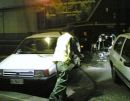By Nicole Martinelli
 You’ve just come from a party after staying a little later than expected. Although slightly bleary-eyed, you have no trouble finding your car: It’s the only one in the street. With a big, fat ticket on the windshield serving as a reminder to always check the street-cleaning signs.
You’ve just come from a party after staying a little later than expected. Although slightly bleary-eyed, you have no trouble finding your car: It’s the only one in the street. With a big, fat ticket on the windshield serving as a reminder to always check the street-cleaning signs.
For some forgetful folks in Milan, this will be just a memory. The city recently started experimenting with a system that cleans underneath parked cars. A powerful jet of water that pushes out debris will end the game of musical parking spaces played by the drivers of 16,000 cars every week.
Milan, one of the most car-choked cities in Europe, is fertile ground for the yearlong trial. Eurostat estimates Milan has 627 vehicles per 1,000 residents, compared to 325 in Berlin and 240 in London. The U.S. average, at 771, is still distant but statistics crunchers report that European car ownership has doubled in the last 25 years. That’s a lot of cars parked on narrow, irregular and dirty cobblestone streets.
“Italian cities, like many old cities, were not designed to be cleaned by machines,” said Angelo Banfi, an executive of Amsa, Milan’s cleaning and sanitation company. “They were built to be defended from invaders. Keeping things tidy was strictly manual labor.”
That didn’t discourage the company from teaming up in 2000 with an engineering studio to find a way to wash under cars. They studied a model similar to a gas-powered leaf blower but nixed it for the noise and residual dust. Then they thought of water.
The patented device, officially called l’agevolatore (“the facilitator”), is a fairly simple one. A jointed steel arm perches on a water cistern with a hose trailing down: The hose nozzle sprays water at high pressure. Human cleaners walk ahead of the trucks, maneuvering the hose a bit like a giant joystick to direct the water. Debris jets into the path of the truck and is whisked away. The whole shebang, fitted onto existing street sweepers, costs about 30,000 euros (roughly $38,000) per sweeping vehicle.
“It does make my job easier,” said Pasquale Sanguedolce, manning the device on a recent late-night shift.
That’s if you know what you’re doing. This layperson’s feeble attempts at using it resulted in a haphazard wash of a Lancia Ypsilon instead of the asphalt underneath it. By way of consolation, Sanguedolce, a 15-year Amsa veteran, mentions he had four hours of training to ensure against directing the 4 gallons of water a minute in the wrong places.
“So far, people love not having to move their cars,” said Sara Piccardi, head of the Amsa press office. “We’ll see if there are complaints about finding debris lodged under tires or whether people call up hysterical because we sprayed the car and they’re going to a wedding.”
Maybe you can’t have it all. The facilitator will never clean the whole city, because the arm isn’t suitable for tree-lined streets or ones with tram lines. During the trials, a 15-machine fleet will cover 80 kilometers (about 50 miles) of city streets. By year’s end, more than 30,000 cars will be able to stay put for the night. For some, those “d’oh!” moments will certainly be reduced.
“It happens to everyone, including me,” Piccardi said. “I went to a girlfriend’s for dinner. When I left, there was my car, all by itself on the street with a ticket. We all know streets need cleaning, but it can be a real hassle.” This story first appeared on Wired news.
